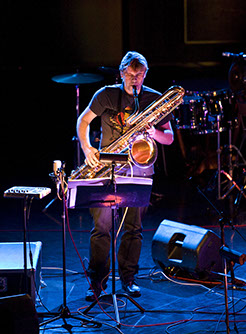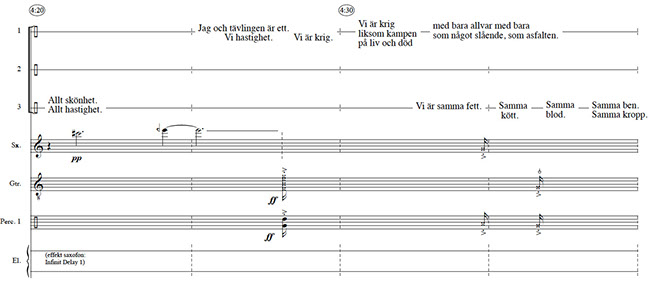Examples
Read more
Examples
5.1.7-5.1.11
The text that Dahlqvist wrote for Indy500: seklernas udde has strong musical qualities. It made it easy for me to feel and imagine a larger musical form and it immediately gave me ideas for how certain sections could sound and be shaped musically. The way of writing was not something that we had really discussed on beforehand, but were rather a part of Dahlqvist’s style of writing. Three aspects of the text in Indy500: seklernas udde were particularly important for the musical composition of the work. They are:
1. Concrete things, events and situations
As I outlined in the end of last chapter, many of my instrumental musical works have had strong programmatic references to non-musical material, but it has not been a matter of imitation but to create a music of becoming, to use Deleuze and Guattari’s term (Cobussen 2007). In musical works with texts this can naturally be a possible compositional approach, but of course do not have to be, as the music can take on a more independent role towards the text. A common approach in our works is that parts of the musical composition are developed out of ideas and sound material based on very concrete things in the texts. In Indy500: seklernas udde, I used the sounds of the speeding racing cars, motors and machines. There were on the one hand sampled sounds from recordings of such sources and, on the other, imitations of these sources as a ground for the musical material for the instrumental parts.
EXAMPLE 5.1.7. Sound: Part E (Score from 7:05)
EXAMPLE 5.1.8. Sound: Part D
For the structure of the macroform the idea of the car race was central. The first sections of part one is the preparation for the race while the last section of part one the race itself, with a voice counting the 168 rounds. I used the counting as a fundamental form structure to compose that section.
Tick. Tack.
Tick. Tack.
Tick. Tack.
Tick. Tack.
Tick. Tack.
Tick. Tack.
Tick. Tack.
1 Nu börjar det. Tävlingen kan äntligen börja. Mina damer och herrar. Välkomna till världens största sportsevenemang. Låt inga andra tankar uppta er tid. Vi äger er i tvåhundra varv. Tänd grillarna. Öppna ölen. Låt tävlingen börja.
Part D (The race)
1 Now it begins. The race can finally start. Ladies and gentlemen. Welcome to the greatest sport event in the world. Don't let any other thoughts occupy your time. We own you in two hundred round. Lit the barbecue. Open the beers. Let the race begin.
1 Det finns ingen tid. Det finns ingen tid. Tiden finns inte. Tiden finns inte. Allt går för långsamt. Hur fort än däcken byts går det för långsamt. Hur fort än motorn rusar, hur fort vi än tar kurvorna, hur mycket vi än trimmar vår organisation, hur fort vi än lär oss fylla på bränsle tar det ändå för lång tid. Allt tar för lång tid.
1 Det finns ingen tid.
2 Det måste gå snabbare. Snabbare. Snabbare.
3 Det finns ingen tid.
2 Vi måste skynda oss.
3 Det finns ingen tid.
1 Konsumera tid.
2 Snabbare.
3 Snabbare.
2 Konsumera.
1 Krig.
3 Snabbare.
2 Tid.

1 There is no time. There is no time. The time does not exist. The time does not exist. Everything is too slow. No matter how fast the tires are changed, it is too slow. No matter how fast the engine rushes, how fast we take the curves, how much we trim our organization, how fast we learn to fill the fuel, it still take too much time. Everything takes too much time.
1 There is no time.
2 It must go faster.
Faster
Faster
3 There is no time.
2 We must hurry
3 There is no time.
1 Consume time.
2 Faster
3 Faster
2 Consume.
1 War.
3 Faster.
2 Time.
Photo: Leif Johansson
2. Repetitive text sections
There are numerous sections with extended repetitions of words and phrases in Indy500: seklernas udde, as the section in part B that repeats the phrases: ‘Ray vet. Ray vet och Kenny vet. Kenny vet. Kenny vet. Han har segrat. Han har segrat. Han vet. Han vet. Kenny vet. Kenny vet och Ray vet. Och gud vet. Och gud vet och Kenny vet.’
Ray knows. Ray knows and Kenny knows. Kenny knows. Kenny knows. He has won. He has won. He knows. He knows. Kenny knows. Kenny knows and Ray knows. And god knows. And god knows know and Kenny knows.
EXAMPLE 5.1.9. Sound: Part B (Score from 8:40)
There is the monotone counting of the rounds of the race in the middle section and there is the ‘tick, tack, tick, tack’ just before the race: the sound of a clock counting down to the start. There is also a section where different companies’ trademark names are enumerated, ‘Marlboro. Philip Morris. Mobil. Bosch. Camel. Argent. 7-eleven. Coca-Cola. Pepsico. Kodak. National. …’
EXAMPLE 5.1.10. Sound: Part A (Score 2:05 - 3:30)
3. Non-relational text division between performers, the ‘ping-pong’ texture
One important feature of Indy500: seklernas udde was the particular divisions of the text in short chunks between the actors, which we often referred to as ”Ping-Pong” texture. Words and phrases are “jumping” between the performers, as calls and responses, but not as relational dialogues. Instead it is either one single text stream that is divided or it is being made up of several independent, superimposed streams. It was used in many sections and had a very musical quality, which became especially apparent directly when I first recorded the voices. It reminded me of a chamber ensemble group playing, as the kind of musical “conversation” that can be found for examples in many classical string quartets. In the compositional process I often composed the instrumental parts to these text sections as additional voices in the “conversations”.
This way of dividing the text are found already in the beginning of the work where Jörgen intertwined the fourth paragraph from the futuristic manifest with his own words:
1: Det finns tre storheter: Hastighet, acceleration och massa.
Och störst av dom är hastighet. Även hastigheten hastighet.
3: Även jag hastighet.
1: Allt hastighet.
3: Även jag hastighet.
2: Vi förklarar världens härlighet…
3: Även jag hastighet.
2: … berikats med ny skönhet: fartens skönhet.
3: Även jag hastighet.
2: En racerbil med motorhuven prydd…
3: Även jag hastighet.
2: … med stora tuber som liknar ormar med explosiv andedräkt.
Another example is in part A, at 4:10 in the score
1 There are three great entities: Speed, acceleration and mass.
And the greatest of them is speed. Also the speed speed.
3 Also I speed
1 Everything speed.
3 Also I speed
2 We affirm that the world’s magnificence has been enriched by a new beauty...
3 Also I speed
2 the beauty of speed.
3 Also I speed.
2 A racing car whose hood is adorned … with great pipes, like serpents of explosive breath.)
From a compositional perspective, these kinds of repetitions have two fundamental functions. Firstly, repetitions of words or phrases often give a sense of rhythm and thus, can be perceived as having a musical quality. In such text sections, words and phrases can easily be rearranged and extended if needed for compositional reasons. Secondly, repeating a word or a phrase over and over has a tendency of making us hear it differently, sometimes emptying the repeated words of their semantic content. Through this detachment the sonic aspects of the text are brought forward.
EXAMPLE 5.1.11. Sound: Part A (Score from 4:10)


3 Det finns bara hastighet. Det finns inget annat. Hastigheten skönhet.
3 Allt skönhet. Allt hastighet.
3 Det är en avledande manöver Allt är teater. Hela tävlingen ett bländverk. Det är världens största spektakel.
Inget annat får finnas den dag loppet avgörs. Nu ser du och nu inte.
Nu ser du och nu inte.
Nu ser du och nu inte.
Dom är ödet. Dom är ställföreträdande smärta.
2 Jag existerar bara under de tvåhundra varv som tävlingen existerar.
2 Vi är samma fett. Samma kött. Samma blod. Samma ben. Samma kropp. Min kropp och tävlingens kropp går inte att skija åt. Dom är samma. Dom har blivit samma.
2 Kulorna följer / sin bana
1 Jag hastighet.
1 Jag och tävlingen är ett. Vi hastighet. Vi är krig. Vi är krig liksom kampen på liv och död
med bara allvar med bara som något slående, som asfalten.
1 Vi är samma.
Vi är hastighet. Vi är krig. Vi är allvaret hos tävlingen som är krig som är tävling, som liknar ett krig som också är det. Inga andra tankar behöver tänkas. Allting är bara tävling. Allt är bara dessa gevärskulor som skyndar längs betongräcke och asfalt varv efter varv i en kamp på liv och död.
Dom följer
sin bana.
